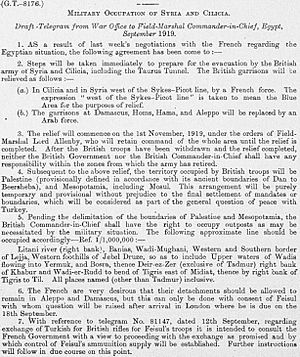Occupied Enemy Territory Administration facts for kids
Quick facts for kids
Occupied Enemy Territory Administration
|
|||||||||||||||||||||||||||
|---|---|---|---|---|---|---|---|---|---|---|---|---|---|---|---|---|---|---|---|---|---|---|---|---|---|---|---|
| 1917–1920 | |||||||||||||||||||||||||||
|
Flags of France and the United Kingdom, as well as the flag of the Arab administration in OETA-East
|
|||||||||||||||||||||||||||

Area of the OETA, according to the British Government's History of the Great War Based on Official Documents
|
|||||||||||||||||||||||||||
| Status | Occupied territory | ||||||||||||||||||||||||||
| Common languages | Arabic, Hebrew, Ottoman Turkish, English, French | ||||||||||||||||||||||||||
| Administrators | |||||||||||||||||||||||||||
| History | |||||||||||||||||||||||||||
|
• Established
|
23 October 1917 | ||||||||||||||||||||||||||
|
• San Remo conference
|
19 to 26 April 1920 | ||||||||||||||||||||||||||
|
• Disestablished
|
1920 | ||||||||||||||||||||||||||
|
|||||||||||||||||||||||||||
The Occupied Enemy Territory Administration (OETA) was a temporary government. It was set up by British, French, and Arab military forces. This administration managed parts of the Middle East between 1918 and 1920. These areas had been part of the Ottoman Empire for about 400 years.
OETA was created on October 23, 1918, after the Sinai and Palestine Campaign and the Arab Revolt during World War I. The British military was in charge, but they had agreed with the French and Arab leaders on how to share control. For example, the French got control of some areas, and the Hashemites (an Arab royal family) helped manage the eastern region.
In December 1918, a new area called OETA North was added after the region of Cilicia was taken. The OETA administration ended in OETA West and OETA South in 1920. This happened after new agreements were made at the San Remo conference. These agreements led to the creation of the Mandate for Syria and the Lebanon and the British Mandate for Palestine.
In OETA East, British control ended in November 1919. The Arab Kingdom of Syria was then declared in that area. However, this kingdom was later split into two parts after the French defeated King Faisal in July 1920. The northern part joined the French-controlled OETA West. The southern part became a "no man's land" and later the Emirate of Transjordan.
Some areas like Marash, Aintab, and Urfa became part of Turkey after 1921. This was due to the success of the Turkish War of Independence. Also, the areas of Antakya and İskenderun became a separate state called Hatay State in 1938. Turkey then took control of Hatay in 1939 after a vote.
Contents
History of OETA
How OETA Started
On October 23, 1918, after British and Arab forces defeated the Ottoman Empire, a British general named Edmund Allenby announced how the land would be governed. He divided the former Ottoman lands into three main areas. These areas were similar to the old Ottoman divisions:
- OETA South: This area included Jerusalem, Nablus, and Acre. It was the first step towards what would become Mandatory Palestine.
- OETA West: This area included Beirut, Mount Lebanon, and some smaller districts. It was first called OETA North but was renamed two months later.
- OETA East: This area included Damascus and the southern part of Aleppo. This region was later claimed by the Kingdom of Hejaz.
In December 1918, after the region of Cilicia was taken, a new area was created:
- OETA North: This new area covered the Adana region.
Life Under OETA
Under the OETA government, the basic needs of the people were met. Things like seeds for farming and livestock were brought in and shared. Money was made available through army banks, and a stable currency was set up. Even postal services were brought back. General Allenby made it clear that as long as the military was needed to run things, it would be his responsibility.
Leaders of OETA
OETA South Leaders
OETA South was divided into four smaller areas: Jerusalem, Jaffa, Majdal, and Beersheba. Each of these had a military governor. The first two British leaders, Generals Money and Watson, were removed. This happened because they were not seen as favoring the Zionists (Jewish people who wanted a homeland in Palestine) enough. When OETA South ended, a politician named Herbert Samuel became the first civilian leader.
OETA East Leaders
OETA East was run jointly by Arab and British military forces. When the Arab and British armies entered Damascus on October 1, 1918, Ali Rida al-Rikabi was appointed as the military governor. Prince Faisal, son of King Hussain of Mecca, arrived in Damascus and made Rikabi the head of the Council of Directors for Syria.
- Rida al-Rikabi (October 3, 1918 – November 26, 1919)
OETA West Leaders
- Marie Antoine Philpin de Piépape (October 7, 1918 – November 19, 1918)
- Jules Camille Hamelin (November 19, 1918 – November 21, 1919)
- François Georges Barb (November 21, 1919 – September 1, 1920)
OETA North (Cilicia) Leaders
- Édouard Brémond
How OETA Was Set Up
The OETA was officially created on October 23, 1918. It followed the rules for military occupation. The plan for OETA was detailed in a secret telegram.
This telegram explained:
- The land taken from the enemy would be divided into three areas.
- Each area would have a "Chief Administrator" who reported directly to the Commander-in-Chief.
- The goal was to keep the old Turkish government system working as much as possible.
- The administrators were told not to get involved in political arguments. Their job was to keep order and security.
When OETA Ended
The OETA administrations ended at different times in each region. This happened as new civilian governments were put in place:
- OETA South: Ended on July 1, 1920. Herbert Samuel became the first High Commissioner for Palestine.
- OETA West: Ended on August 31, 1920. General Henri Gouraud announced the creation of Greater Lebanon and the Alawite State.
- OETA East: Ended on November 26, 1919. The British troops left, and the Emirate of Syria took control.
Images for kids






